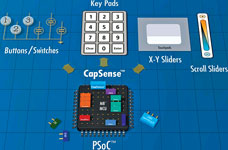Capacitive touch sensor solution provides a flexible alternative to mechanical controls
29 June 2005
DSP, Micros & Memory

Information from Analog Data Products
Cypress Semiconductor's CapSense technology is a new capacitive touch sensor interface based on its programmable system-on-chip (PSoC) mixed-signal arrays. A single PSoC device can replace dozens of mechanical switches and controls with simple, touch-sensitive controls.
CapSense-based buttons and slider controls are more reliable than their mechanical counterparts because they are not prone to the environmental wear-and-tear that affects exposed buttons and switches.
Cypress' CapSense solution offers system designers numerous advantages over capacitive touch sensor products built around modules and sub-assemblies, including increased flexibility, reduced board space and lower cost. Because of the unique PSoC architecture, designers can easily integrate multiple functions (eg, LED drivers and LCD displays), in addition to touch sensing. The PSoC CapSense solution also delivers benefits such as easy serial communications using either I²C or SPI interfaces, the ability to implement both trackpad (x-y matrix) and linear slider applications with the same device, and the ability to make quick design changes using the flash-based PSoC architecture.
Capacitive sensing is fast becoming the solution of choice for front-panel display and media control applications. Increased durability, decreased bill of materials (BOM) and a clean, minimalist appearance make this elegant interface attractive to a wide range of designs. With CapSense technology, a finger on the interface forms an electrical connection with embedded sensors, which work with the PSoC device to translate data about the finger's position into various system control functions. Cellphone users can slide a finger along their screen to change the volume of a call, the brightness of the screen or the loudness of a ring tone without having to end the call and click through complicated menu structures. In notebook computers, 'touchpad' sensors have already replaced external mice for cursor movement. Applications abound in consumer, industrial, white goods, automotive and medical devices - in short, any area where durability, ease of use and price are major considerations.
CapSense is built around Cypress' CY8C21x34 family of PSoC devices. PSoC mixed-signal arrays are programmable SOCs that integrate a microcontroller and the analog and digital components that typically surround it in an embedded system. A single PSoC device can integrate as many as 100 peripheral functions and a microcontroller, saving customers design time, board space, power consumption, and system costs.
Further reading:
Memory for asset tracking
Altron Arrow
DSP, Micros & Memory
The Page EEPROM, ST’s latest memory, has been designed for efficient datalogging and fast firmware upload/download in battery-operated devices.
Read more...
Engineered for high-reliability applications
Future Electronics
DSP, Micros & Memory
The MCX E series of Arm Cortex-M4F and Arm Cortex-M7 microcontrollers from NXP are engineered for demanding industrial and IoT environments.
Read more...
NXP’s development platform guide
DSP, Micros & Memory
Choosing between the FRDM i.MX 93, FRDM i.MX 91 and FRDM i.MX 91S development platforms can be intimidating, but once designers understand how each platform aligns with their application’s requirements, the decision becomes straightforward.
Read more...
XJTAG launches two new Flash programmers
ASIC Design Services
DSP, Micros & Memory
XJTAG has announced XJExpress and XJExpress-FPGA, a pair of Flash programmers perfect for development, debug and in-service applications.
Read more...
Processor offers competitive solution for advanced HMIs
Future Electronics
DSP, Micros & Memory
The new RZ/A3M microprocessor from Renesas features 128 Mbytes of fast DDR3L DRAM memory for system cost reduction, and supports
1280 x 800 px video resolution at a rate of 30 frames/s.
Read more...
ESP32-C6 achieves PSA-L2
iCorp Technologies
DSP, Micros & Memory
Espressif Systems recently announced that its ESP32-C6 microcontroller has achieved PSA Certified Level 2 (PSA-L2) security certification, making it the first RISC-V-based MCU to reach this level.
Read more...
Microprocessor with integrated NPU
Avnet Silica
DSP, Micros & Memory
The RZ/G3E from Renesas is a microprocessor integrated with quad CPU and NPU in one chip, improving power efficiency, reliability, and security.
Read more...
Nordic Semiconductor launches nRF Connect SDK Bare Metal option for nRF54L series
Avnet Silica
DSP, Micros & Memory
This is a new, RTOS-independent software solution for Bluetooth LE development, designed to ease developers’ migration from the legacy nRF5 SDK and nRF52 series to the next-generation nRF54L series.
Read more...
Dual-core support in NECTO Studio
DSP, Micros & Memory
MIKROE recently announced that version 7.3.0 of its NECTO Studio Integrated Development Environment now supports dual-core MCUs, allowing designers to program and debug each core independently.
Read more...
Post Quantum Cryptographic firmware library
DSP, Micros & Memory
The STM32 post-quantum cryptographic library enables developers to satisfy application requirements for any combination of data integrity, confidentiality, identification/authentication, and nonrepudiation.
Read more...


